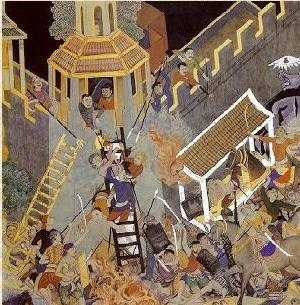Tamil place names in Malaysia
The name Malaya is a combination of two Tamil words, மலை Malay or Malai (hill) and ஊர் ur (town) meaning hilltown” (Malaiyur). There is also another hill-town in Sumatra (Malayadvipa),[1] which had been given the same name Malai-Yur which later became Malayu (see Melayu Kingdom). Till the time of I-Tsing (671 AD), this was known as Jambi.[2]
The name Malaiyur, also spelt Mazhaiyur, is a small town in Thiruvannamalai District of Tamil Nadu, India. Malaiyur is 110 km south-west of Chennai at Latitude (lat): 12°30'0"N and Longitude (lon): 79°29'0"E. Located on Chetpet-Vandavasi Road, the town is midway between Chetpet and Vandavasi.[3]
Manigramam
Literal meaning of Manigramam in Tamil is “gem like town”. This is to be identified in the Malay peninsula as a trading center of the Tamils from the Coromandel Coast. Manigramam occurs in Tamil inscriptions of the Malabar coast.[4]
Tondi
There are two places in the Tamil country with the same name Tondi – one in the Chera Empire and the other one in the Pandyan Empire. However, there seems to have been a third Tondi in the Malay Peninsula.[2]
A reference to the Malayan Tondi occurs in the Tamil epic Silappadikaram which was first discovered by Nilakanta Sastri and later reported by Tom Harrison (1949), thus:
“Having entered together with the est wind that came laden with (the aroma) of aloe, silks, sandal, spices and camphor put by the residents of Tondi on board a fleet of tall roomy ships.”[2]
Takkolam (Takuapa)
Takuapa of the northern part of the Malay Peninsula is otherwise known as Takkolam. Takkolam is the Tamil word for “piper cuveba’ and “calyptranthes jambalana. There is also a place in the Tamil country which up to now carries the same name Takkolam. The Malaysian Takuapa could have been either abounded by the spices “calyptranthese jambalana” and “piper cubeba” or it could have been occupied by settlers from the Takkolam of the Tamil country, or both.[2]
Kadaram (Kedah)

Kedah, the west coast of Malaya, is known as Kadaram in Tamil. Kadaram-kondan “conqueror of Kadaram” was one of the attributes given to Rajendra Cholan I of the Tamil Chola empire of the early 11th century AD. There is also a place in the Madurai District in Tamil Nadu, of the Pandyan Empire, with the name Kadaram.[2]My village in Tanjore District[ in chola empire],near Mayavaram[Mayiladuthurai ,now] is 'Kadaram kondan'. A large and round fruit, which is a species of orange, with sour and bitter taste (not grapefruit) is called by the Tamils as kadarangkay, kadaram-pulp. This variety of orange was brought by the Tamil traders from Malaysia to Tamil Nadu, or the place abounded by this pulp could have been named after it by the Tamil settlers in Malaya.[2]
Kedah in the Malay language means 'open wide'which is apt as Kedah is primarily made of padi fields which as flatlands. So Negeri Kedah would be 'Wide Open State'. Place names in Malaysia tend to be Malay words that describe the nature of the place or the plants or animals that are abundant there.
Mayirudinggam, Mappappalam, Mewilimbanggam, and Madamalingam
Mayirudinggam, Mappappalam, Mewilimbanggam, and Madamalingam are to be identified in the northern part of the Malay Peninsula. These are among the several states that were part of the Sri Vijaya empire but were overwhelmed by Rajendra Chola I in 1025 AD. A Tanjore Inscription which commemorates this victory mentions the place names.[2][5]
Cheras
Cheras in Malaysia is a suburb located in both Kuala Lumpur and Selangor. Originally, Cheras is the name of a kingdom in ancient Tamilakkam. Outside of Malaysia on the central part of the island of Sumatra are a group of people called the Karo Bataks carrying Dravidian clan names such as Chera, Chola, Pandya, and Pallava.
References
- ↑
- ↑ 2.0 2.1 2.2 2.3 2.4 2.5 2.6 Arokiaswamy, Celine W.M. (2000). Tamil Influences in Malaysia, Indonesia, and the Philippines. Manila s.n. pp. 43, 45–47, & 49.
- ↑ "Malaiyur in Malaiyur India". India9.com. 2005-07-29. Retrieved 2013-10-15.
- ↑ Hultzach, E. (1913). "Note on a Tamil Inscription in Siam". Royal Asiatic Society of Great Britain and Ireland Journal. 3rd Series. s. 1 & 2.
- ↑ Coedes, Georges (1968). Indianized States of Southeast Asia. Honolulu: East-West Center.
